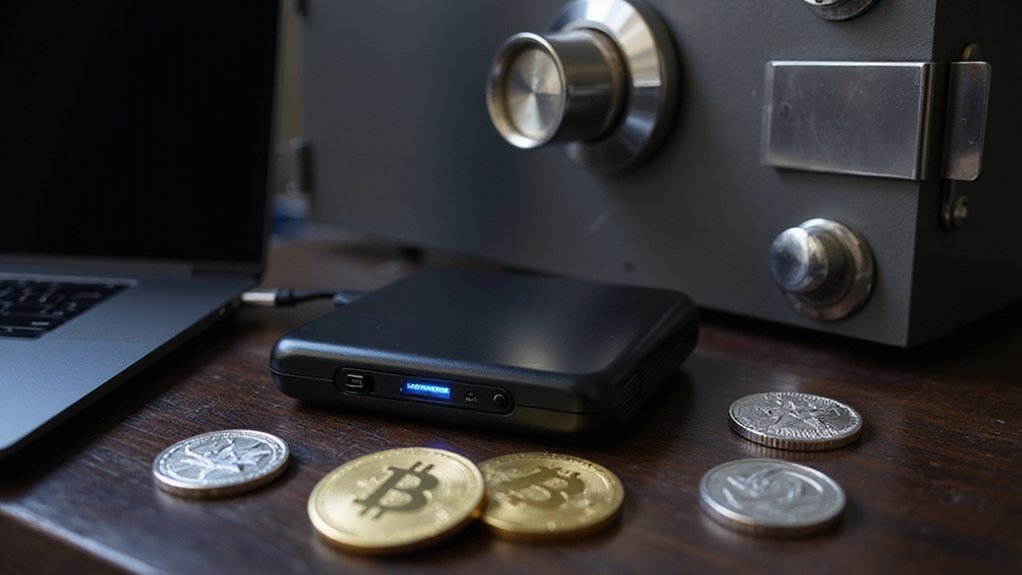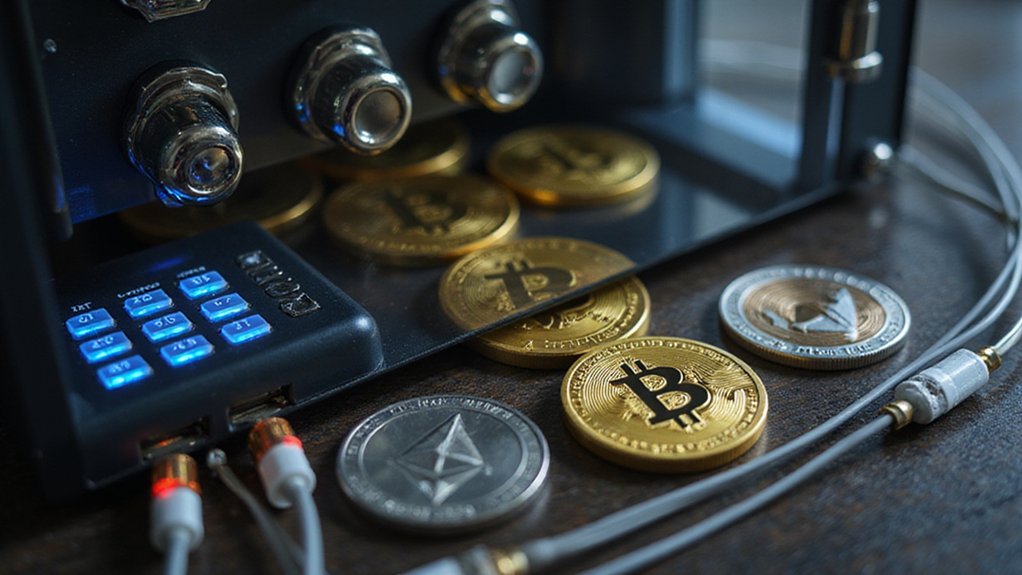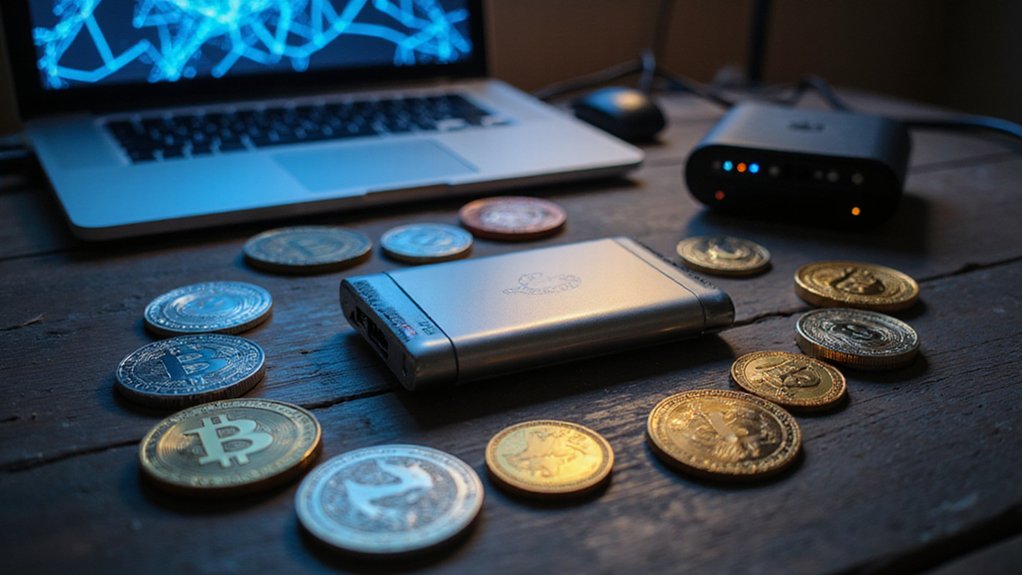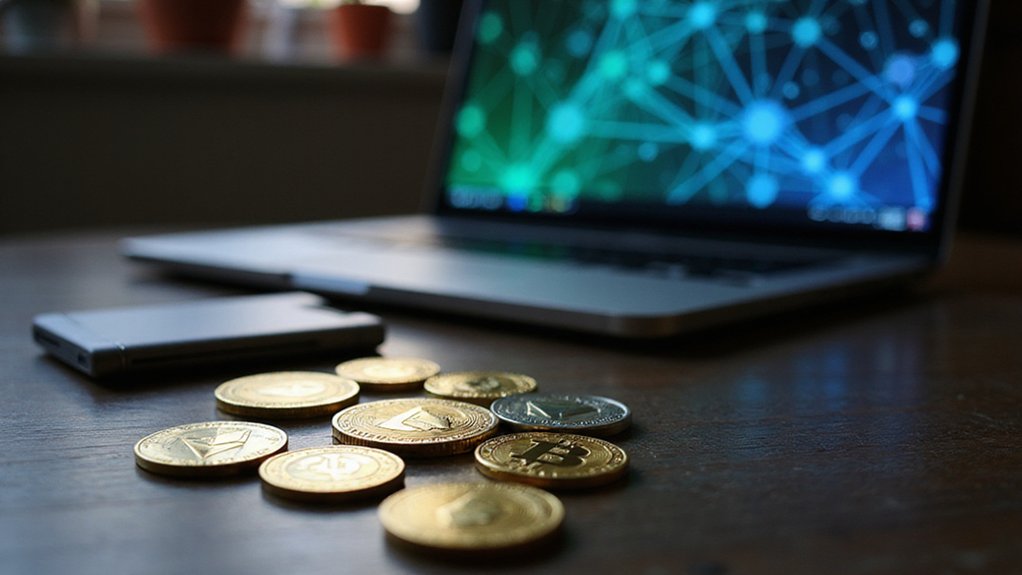Blockchain security presents a delicious irony: technology designed to eliminate trust instead demands unprecedented vigilance from users who must simultaneously function as their own banks, security departments, and compliance officers. With $40.9 billion flowing to illicit cryptocurrency addresses in 2024, protecting digital assets requires rigorous smart contract auditing, sophisticated oracle manipulation defenses, and real-time monitoring tools like Chainalysis Hexagate. The emerging security standards and regulatory frameworks across thirty jurisdictions suggest deeper complexities await exploration.

The blockchain revolution, for all its promises of decentralization and trustless systems, has managed to create an entirely new category of trust problems that would make traditional financial security experts weep into their risk assessment spreadsheets.
The irony is palpable: technology designed to eliminate intermediaries has spawned an ecosystem where approximately $40.9 billion flowed to illicit cryptocurrency addresses in 2024 alone—a figure that conservative estimates suggest could reach $51.3 billion when accounting for undiscovered criminal activity.
Smart contract exploits represent perhaps the most sophisticated threat vector, where poorly coded protocols become expensive lessons in the importance of rigorous auditing.
These vulnerabilities, combined with oracle manipulation attacks that compromise data integrity, demonstrate how blockchain’s distributed nature can amplify rather than mitigate certain risks.
Cross-chain bridge attacks have proven particularly lucrative for bad actors, exploiting the complexity inherent in connecting disparate blockchain networks.
The Blockchain Security Standards Council has responded to these evolving threats by establishing thorough frameworks including the Node Operation Standard, Token Integration Standard, Key Management Standard, and General Security and Privacy Standard. These comprehensive standards represent a milestone in the blockchain security journey, designed to elevate trust in digital assets and boost confidence in blockchain networks.
These guidelines acknowledge what many early adopters learned the hard way: decentralization without proper security protocols is merely organized chaos with cryptographic signatures.
Real-time monitoring through blockchain analytics tools like Chainalysis Hexagate has become essential infrastructure, enabling proactive threat detection in an environment where traditional security perimeters simply don’t exist.
The technology’s transparent nature—once considered an unqualified advantage—now requires sophisticated privacy protection measures to prevent transaction data leakage.
Regulatory frameworks across more than thirty jurisdictions continue evolving to address these security challenges, though the pace of technological innovation consistently outstrips legislative responses. The European Union’s adoption of Markets in Crypto-Assets regulation exemplifies efforts to balance consumer protection with innovation incentives in the digital asset space.
This regulatory lag creates compliance complexities that would challenge even seasoned financial institutions. Selecting reputable exchanges with robust multi-factor authentication protocols remains one of the most critical decisions for investors seeking to protect their digital assets from unauthorized access.
The fundamental challenge remains unchanged: protecting digital assets in an ecosystem where users serve as their own banks, security departments, and compliance officers.
While blockchain security innovations continue advancing, the economics of crypto crime suggest that defensive measures must evolve faster than the considerable ingenuity of those seeking to exploit systemic vulnerabilities.
Investor confidence ultimately depends on this perpetual arms race between security innovation and criminal creativity.
Frequently Asked Questions
What Happens to My Crypto if I Forget My Private Key?
When someone forgets their private key, their cryptocurrency becomes permanently inaccessible—a digital equivalent of losing the only key to a safety deposit box.
The blockchain’s decentralized architecture offers no customer service hotline or password reset button.
Those funds effectively vanish into the cryptographic ether, contributing to the estimated $140 billion in stranded Bitcoin.
Without backup seed phrases or partial key recovery tools, the assets remain forever locked in their digital vault.
Can Quantum Computers Break Blockchain Encryption in the Future?
Quantum computers pose a genuine threat to blockchain encryption, with researchers estimating that sufficiently powerful systems could crack Bitcoin signatures within thirty minutes and RSA keys in roughly eight hours.
However, this doomsday scenario remains decades away, as current quantum systems suffer from prohibitively high error rates.
Meanwhile, NIST has already released post-quantum cryptography standards, suggesting the industry won’t simply wait around for cryptographic Armageddon.
How Do I Safely Transfer Crypto Between Different Wallets?
Safe crypto transfers require meticulous attention to detail—one mistyped character can send assets into the digital void permanently.
Users should verify recipient addresses multiple times, utilize hardware wallets for significant amounts, and test with small transactions first.
Two-factor authentication remains essential, while secure networks prevent interception.
Given quantum computing’s looming threat to encryption (as previously discussed), employing multiple wallet types and maintaining offline storage becomes increasingly prudent for long-term asset protection.
What’s the Difference Between Hot and Cold Wallet Security?
Hot wallets maintain internet connectivity for transaction convenience—naturally making them prime targets for cyber threats and hacking attempts. Cold wallets store private keys offline (typically on hardware devices costing $50-200), providing robust protection against malicious actors.
The fundamental trade-off remains predictably stark: accessibility versus security. While hot wallets excel at frequent transactions, cold storage offers superior protection for substantial holdings—assuming users can resist the temptation of constant trading.
Should I Use a VPN When Accessing My Crypto Accounts?
One should absolutely employ a VPN when accessing crypto accounts, particularly on public networks where data interception resembles shooting fish in a barrel.
Quality VPNs encrypt traffic and mask IP addresses, though they won’t protect against phishing attempts or malware—because apparently hackers possess multiple tricks beyond simple network monitoring.
Choose providers with 256-bit AES encryption and strict no-log policies, given that inadequate VPN selection defeats the entire security premise.









